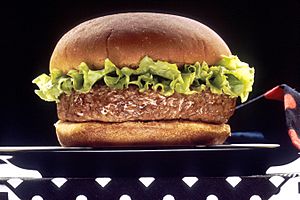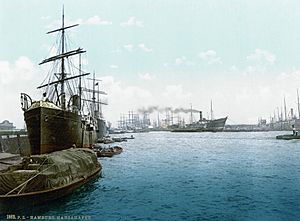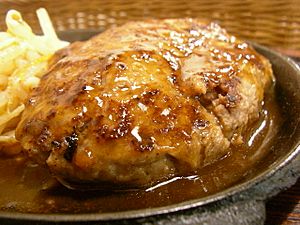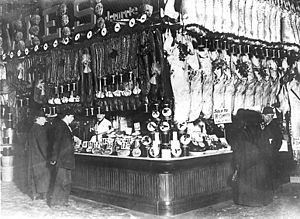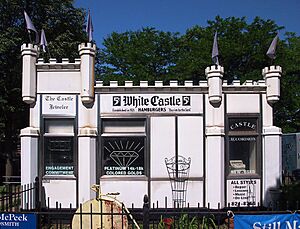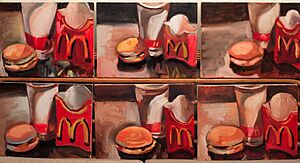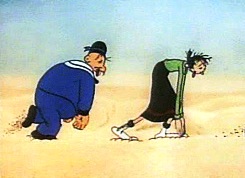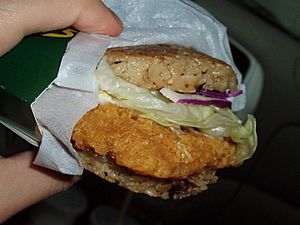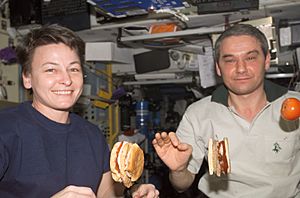History of the hamburger facts for kids
The hamburger is a popular food that first appeared in the 1800s or early 1900s. It became popular as more people worked in factories and cities. They needed quick, cheap food they could eat away from home.
Many people think the hamburger was first made in either the United States or Germany (in the city of Hamburg). It's a sandwich with two slices of bread and a cooked patty of ground beef. People had eaten bread and beef separately for a long time. But putting them together was new! Soon after it was created, the hamburger started to include toppings like onions, lettuce, and pickles. It got its name from the German city of Hamburg.
Today, the hamburger is a famous symbol of American fast food. Like fried chicken and apple pie, it's a well-known American dish. The hamburger's popularity around the world shows how food is becoming more global. Just like pizza from Italy, fried rice from China, and sushi from Japan, the hamburger has spread everywhere. This happened partly because restaurants like White Castle (in the 1920s) and McDonald's (in the 1940s) made it easy to sell processed food to many people.
Contents
Where Did the Hamburger Begin?
Before the hamburger was invented in the U.S., similar foods were already eaten in Europe. For example, an ancient Roman cookbook from the 4th century describes a beef patty mixed with nuts and spices. This might be one of the earliest ideas for a hamburger.
The word "sandwich" wasn't used until the 1700s. It was named after an English aristocrat, John Montagu, 4th Earl of Sandwich, around 1765. He liked to eat sandwiches so he could play cards without getting his hands dirty.
Hamburg and Its Port
In the early 1800s, many Europeans moving to the New World (America) sailed from Hamburg, Germany. New York City was often their first stop. Restaurants in New York started offering "Hamburg-style American fillet" or "beefsteak à la Hambourgeoise." These dishes reminded immigrants of their home city.
Hamburg Steak
In the late 1800s, the Hamburg steak became popular in New York port restaurants. This was a fried patty of chopped beef, sometimes with eggs, onions, and spices. It could also be served raw with onions and breadcrumbs. A menu from Delmonico's restaurant in 1873 shows an 11-cent Hamburg steak. This was quite expensive back then!
By the end of the century, Hamburg steak became cheaper and easier to make. It was even served to patients in hospitals, sometimes raw with a raw egg. Over time, the name "Hamburg steak" changed to "hamburger" by 1930. Now, people often just say "burger." This shorter name is used for other burger types too, like cheeseburger and baconburger.
Who Invented the Hamburger?
Many recipes and dishes came to America with immigrants. Some people think the hamburger came from Europe, while others believe it was created in America to meet new needs. The hamburger we know today likely appeared between 1885 and 1904. Over the next 100 years, it spread worldwide thanks to the idea of fast food and franchise businesses.
North America
A big step in making Hamburg steak popular was the invention of the meat grinder in the early 1800s by German engineer Karl Drais. This machine made it possible to sell large amounts of minced meat at low prices. Before this, mincing meat was hard work done by hand. The meat grinder helped the Hamburg steak become very popular in America, even though its German roots were forgotten by many.
Also, more and more beef was being produced in the U.S. by the late 1800s. America became a huge producer and consumer of beef. This made beef cheap and available to everyone, including the working class. This helped the Hamburg steak become a food for the masses.
At the start of the 1900s, there were concerns about meat safety. A book called The Jungle by Upton Sinclair talked about problems in the meat industry. This led to new laws like the Pure Food and Drug Act, which helped make sure food was safe. This was important for the hamburger, as restaurants had to prove their meat was safe to eat.
Controversial Origins
No one knows for sure who invented the hamburger. Most historians think it was a cook who put a Hamburg steak between two slices of bread. This likely happened in a small town in Texas, or perhaps the founder of White Castle helped create the "Hamburger Sandwich." Records from that time are hard to find.
All the stories about the hamburger's invention are from between 1885 and 1904. They often involve amusement parks, fairs, or festivals, and street vendors selling food.
- Frank and Charles Menches: In 1885, at the Erie County Fair in Hamburg, New York, these brothers ran out of pork sausage. Their butcher suggested ground beef. They added coffee and brown sugar to make it taste good and called it the "hamburger" after the town.
- Charlie Nagreen: In 1885, 15-year-old Charlie Nagreen from Seymour, Wisconsin, sold Hamburg steaks at a fair. People wanted to walk around while eating, so he flattened the steak and put it between two slices of bread. This was called the "Hamburger Charlie." Seymour still celebrates "Burger Fest" every year.
- Fletcher Davis ("Old Dave"): In Athens, Texas, in the late 1880s, Old Dave supposedly put ground beef between two pieces of Texas Toast for a customer in a hurry. He then added it to his menu. He even had a stall at the 1904 St. Louis World's Fair.
- Otto Kuasw: In 1891, a German cook named Otto Kuasw in Hamburg, Germany, made a popular sandwich for sailors. It was a fried beef patty with a fried egg between two toasted buns, called "Deutsches Beefsteak." Sailors traveling to New York might have asked for similar "Hamburg style" sandwiches.
- Louis Lassen: In 1900, Louis Lassen, a Danish immigrant in America, claimed to have created a hamburger steak sandwich with small strips of beef for his restaurant, Louis' Lunch. His family says he invented it in 1900.
Ingredients
Once the Hamburg steak was put between bread, people started adding other ingredients.
- Ketchup became a common topping. It was first sold by Henry John Heinz in 1869.
- Mustard is much older, used by ancient Romans.
- Mayonnaise appeared in France in the 1700s.
- Onions, sliced in rings, were one of the first vegetables added.
- Other veggies like lettuce and pickles also became popular, making the burger look and taste more natural.
French fries also became a popular side dish. They originated in Belgium around 1680. They became very popular in America when big fast food companies like McDonald's and Burger King added them to their menus in the mid-1900s. New ways of freezing potatoes made it possible to make huge amounts of fries.
Cola drinks also became common with hamburgers. Coca-Cola was invented in 1885, and Pepsi followed soon after. Big burger chains partnered with these drink companies, making them widely available.
How Hamburgers Became Big Business
At the start of the 1900s, cities were growing fast, and people needed cheap, quick food. The hamburger was perfect for this. New ways to preserve food and better transportation also helped. The hamburger became popular after World War I and during the Great Depression because it was so inexpensive (often just five cents!).
New ways of doing business, like the assembly line for cars, also influenced food. Fast food restaurants offered a new way to eat out. They were often called "greasy spoons" because they were cheap, but sometimes not very clean. However, they offered quick meals for people who were always on the go, traveling by car, bus, or train.
White Castle System
In 1916, Walter "Walt" Anderson opened a hamburger stand in Wichita, Kansas. He used clean cooking methods, which impressed his customers. People started buying his hamburgers by the dozen, leading to the slogan: "buy 'em by the sack."
In 1926, Edgar Waldo "Billy" Ingram teamed up with Anderson to open the first White Castle restaurant. Their idea was to cook hamburgers quickly, making it the first true fast food restaurant. Ingram realized that "burger" had a bad image, reminding people of greasy meat. He worked to change this.
White Castle became known for its "White Castle System." Between 1923 and 1931, they opened almost 100 restaurants across the Midwest. They focused on preparing burgers fast, so anyone could buy and eat them anytime, anywhere. They also made sure their food was clean and hygienic, which was important after books like The Jungle raised concerns about meat safety. White Castle also made sure every burger was served the same way in every restaurant, which was a new idea at the time.
White Castle was the first restaurant to advertise in newspapers. They also started the idea of take-out service. They were known for their square burgers, called "sliders," which sold for five cents. White Castle also made its own packaging and even built its own restaurants with white porcelain walls to look clean.
Walter Anderson also came up with the idea of the "perforated burger" in 1949, adding five holes to the patties. This helped them cook faster and more evenly. White Castle's success led to many competitors, like White Tower Hamburgers.
McDonald's Era
In 1937, Patrick McDonald and his sons, Richard and Maurice, opened a restaurant called "Airdrome" in California. In 1940, they opened McDonald's in San Bernardino, California. They soon realized that 80% of their money came from selling hamburgers!
The McDonald brothers focused on making hot dogs and hamburgers as fast and efficiently as possible. By 1948, they introduced the idea of fast food to the Western U.S. They made it possible to get a burger in just one minute and even eat it in your car (a "drive-in" style). They wanted to make burgers cheap enough for everyone.
In 1953, the McDonald brothers started letting other people open McDonald's restaurants (franchising). In 1955, a salesman named Ray Kroc took over the company. Kroc helped McDonald's expand across the U.S. and made sure all their burgers were the same.
McDonald's also created famous items like the McMuffin (invented by Herb Peterson in 1972) and the Big Mac (invented by Jim Delligatti in 1967). McDonald's even has a training center called Hamburger University! McDonald's became a symbol of globalization, spreading American culture around the world.
Different Kinds of Hamburgers
Many different kinds of hamburgers have been created. Other restaurant chains tried to be as successful as McDonald's and White Castle.
- Big Boy restaurants, started in 1936, were known for their double-deck cheeseburger with two beef patties. They also made drive-in restaurants popular.
- The cheeseburger became very popular. Several chefs claim to have been the first to add a slice of cheese to a hamburger, possibly between 1924 and 1926.
- Burger King opened in 1954. Its founders, James McLamore and David Edgerton, were inspired by McDonald's. Their main product is the Whopper, created in 1957.
- Wendy's was founded in 1969 by Dave Thomas. Wendy's tried to be different by saying they used fresh, not frozen, beef. Their "Where's the beef?" ad campaign in the 1980s became very famous.
Hamburgers in Culture
Hamburgers became very popular in American culture after World War I.
- In the 1930s, the cartoon character J. Wellington Wimpy from Popeye loved hamburgers. His famous line was: "I will gladly pay you Tuesday for a hamburger today." This helped make hamburgers popular with kids.
- Later, Ronald McDonald became a famous clown character for McDonald's in 1963.
- Hamburgers also appeared in pop art by artists like Andy Warhol.
- Even the Millennium Falcon spaceship from Star Wars was designed by George Lucas to look like a hamburger!
By the 1960s, more Americans had cars. Hamburgers were often served at drive-in restaurants, where waiters called "carhops" brought food to your car. The hamburger became a national symbol of the United States. People were eating about three burgers a week!
In the 1970s, big hamburger chains started "burger wars," competing with each other through advertising. They used catchy slogans to attract customers.
Hamburgers Around the World
The modern hamburger started in the U.S., but after World War II, it spread globally. Big restaurant chains wanted to expand and make more money, so they opened franchises all over the world. McDonald's was a leader in this, but others like Wimpy also grew internationally.
As the hamburger spread, it changed to fit local tastes. For example, in Australia, you might find burgers made with kangaroo meat. In some places, they might add chili con carne.
The global spread of the hamburger even led to the Big Mac Index. This is a fun way to compare how much a Big Mac costs in different countries. It helps economists understand how much money people can buy with in different places.
Hamburgers Today
Today, the hamburger is still a big part of our world. Books like Fast Food Nation have explored the impact of the fast food industry.
There are also "gourmet burgers" made by fancy chefs using expensive ingredients like truffles or special beef. But there are also simpler, homemade versions.
In the U.S., some towns argue about where the hamburger was first invented. Athens, Texas, and Seymour, Wisconsin, both claim to be the "Original Home of Hamburger." Seymour still celebrates "Burger Fest" every August.
Hamburgers in Media
Hamburgers have appeared in many movies and TV shows:
- In 2004, the documentary Super Size Me showed a filmmaker eating only McDonald's food for a month to see how it affected his health.
- The movie Harold & Kumar Go to White Castle (2004) was all about a journey to a White Castle restaurant.
- The film Fast Food Nation (2006) looked at the meat industry.
- Hamburgers are also in video games like BurgerTime and TV shows like American Eats.
Images for kids
-
A vegan version of the hamburger.
See also
 In Spanish: Historia de la hamburguesa para niños
In Spanish: Historia de la hamburguesa para niños


